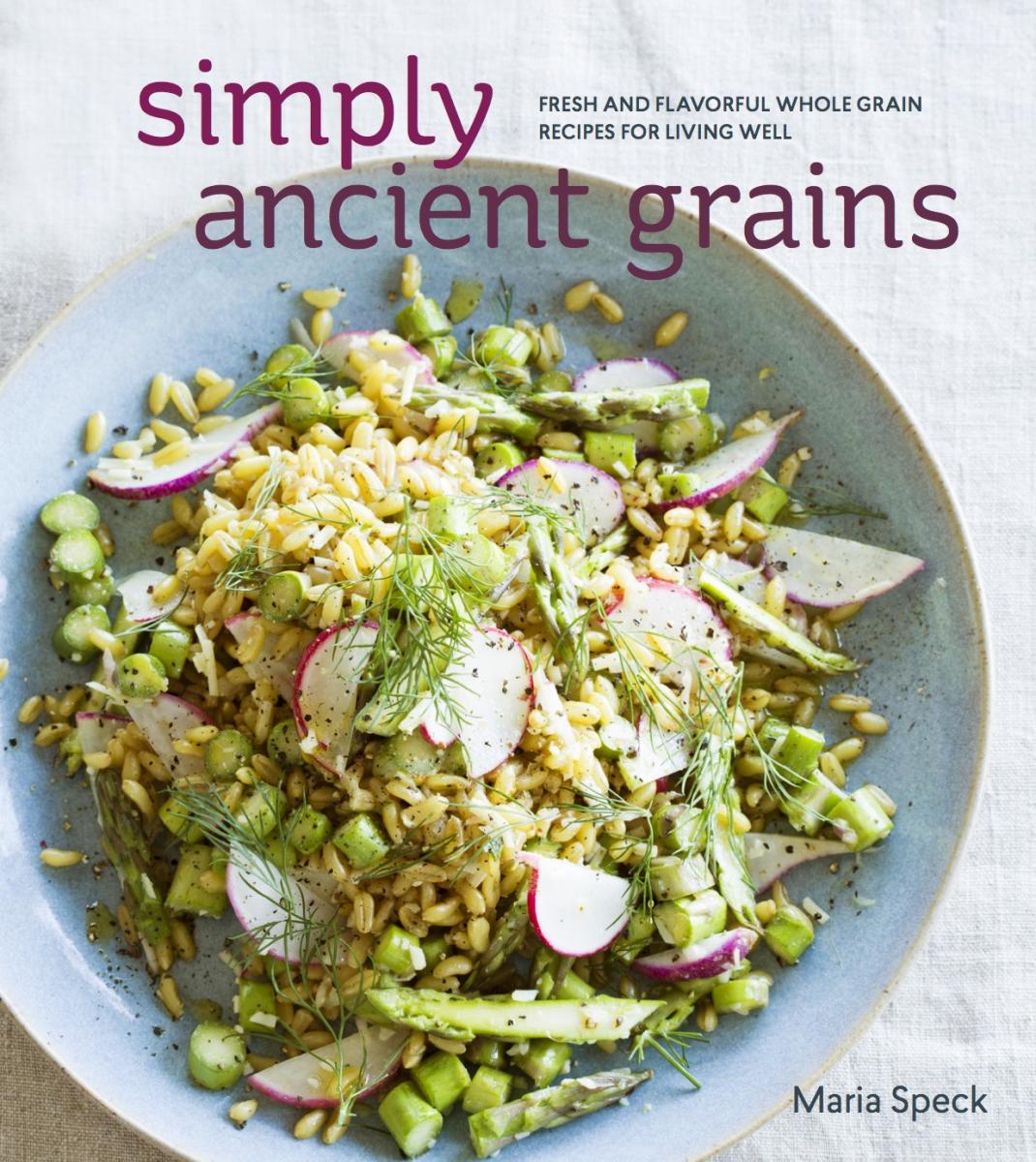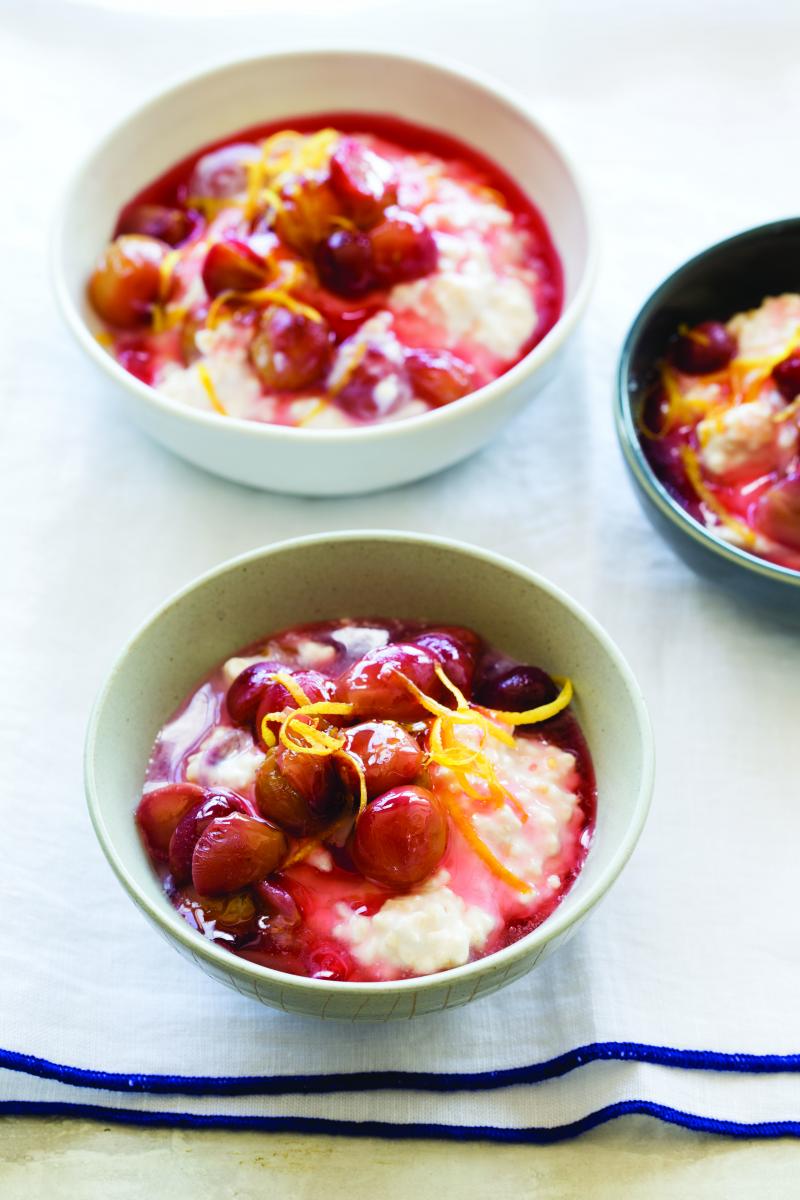Share This
Simply Ancient Grains was perhaps the most anticipated cookbook of the year here at the Whole Grains Council, and we are happy to report that Maria Speck’s thoughtfully written recipe collection exceeded our expectations! The long awaited follow up to her 2011 award-winning book, Ancient Grains for Modern Meals (another WGC favorite), this stunning new cookbook offers a wealth of delectable dishes that showcase the rich, nutty flavors of whole grains.
Today, we are delighted to share a Q + A with this acclaimed author (and WGC Culinary Advisor)! Also, be sure to check out our post on the Oldways Table blog about joining Maria Speck and a few other food experts to cook up some of the recipes from this fabulous new book.
Whole Grains Council: You mention that “we have seen a revival of traditional grains,” since your first book was published in 2011. Which grains have you had the opportunity to learn more about and experiment with more this time around, thanks to increased availability and awareness?
Maria Speck: So many amazing grains have shown up on store shelves just in the past few years—not in my wildest dreams would I have seen this coming. This includes amaranth, teff, and sorghum, all gluten-free, and of course quinoa which has become almost our new household staple. And more recently chefs and bakers have become enamored with smoky freekeh as well as with some of my favorite ancient wheats such as delicate sweet whole grain spelt, buttery Kamut®, and the small einkorn (aka farro piccolo).
WGC: In your new book, you share the two-step method for cooking grains, where grains and batters are prepped the night before, greatly reducing cooking time, while deepening the flavor. Can you share another culinary tip (or two) with our readers that you have picked up over the years that has truly changed your life?
Maria: I am a trained journalist, and have always had whole grains on my table during an intensely busy career with long hours. I always recommend quick-cooking grains for easy weeknight meals. This includes bulgur, millet, buckwheat, whole wheat couscous and polenta; they cook as fast as white rice. And on weekends, make a large pot of slower-cooking grains such as whole wheat berries, spelt, rye, and Kamut, ahead. Then you have these nourishing staples at the ready to toss into salads and soups, or combine them with yogurt and fruit for breakfast. Grains can be stored in the fridge for up to 7 days, or you can freeze them for later use.
WGC: Many of your recipes are inspired by your Greek heritage. What lessons could our Mediterranean neighbors teach us about enjoying more whole grains?
Maria: No one ever told me to eat “healthy” whole grains growing up in Greece and Germany. Staples such as bulgur and cornbread, muesli or whole grain breads were simply on our table as a flavorful part of our meals. Aromatic ingredients are key. Across the Mediterranean people enjoy mouth-watering food, but also cooking and sitting down for a meal together. All my recipes are inspired by this upbringing and its simplicity. Just combining lots of market fresh vegetables with a grain and a simple olive oil dressing can be the best meal.
WGC: We adore your elegant, yet unfussy approach to cooking, letting simple ingredients shine. What small tweaks in a recipe can make a big difference in flavor?
Maria: I have learned from my Greek mom to use fresh herbs in abundance. Instead of adding a tablespoon of chopped herbs you might find me tossing fresh herbs by the fistful into a pot of polenta or a grain salad. Herbs spruce up the flavor and add gorgeous color too. Try the short-cut polenta with Greek yogurt, lemon, and dill—unforgettable. Toasting small grains such as millet, oats, or buckwheat before adding the cooking liquid is another great flavor enhancer. And, of course, a dab of butter or a drizzle of olive oil at the end brings out the best in any grain.
WGC: From simple pilafs to hearty porridge, there are so many wonderful ways to serve whole grains. Is there a particular type of recipe that people shy away from, but is actually a wonderful way to incorporate whole grains?
Maria: My dad was German, and I spent my formative years in Munich. The best thing I ever learned there is to eat muesli for breakfast. It is delicious and will last you through the morning. Best of all, it is super-easy to make at home. My book has a recipe for it. Muesli is celebrated in Germany. On weekends, in coffeehouses, you can order serious bowls of it with nuts and dried fruit, milk or yogurt, and topped with loads of fresh fruit, plus – if you so desire — with softly whipped cream. A Sunday breakfast like this will keep you going for the rest of the day!
WGC: Lastly, could we share a recipe and photo from your new cookbook with our readers?
Of course! May I suggest the lemony millet pudding with caramelized grapes. Reminiscent of rice pudding, this dessert is perfect for adults and children alike. Only lightly sweetened and easy to make ahead, you can serve it even to dinner guests with gluten-free diet needs.
Lemony Millet Pudding with Caramelized Grapes
SERVES 6
Creamy desserts are a perfect foil to showcase millet—they provide enough cover to hide the small grain from plain view yet plenty of appeal to highlight its delicate, toothsome texture. This nimble lemon-infused dessert, similar to rice pudding, is a case in point. Aromatic white wine syrup caramelizes the grapes and ties the ingredients together, showing off this comforting ancient grain. gluten-free
MILLET
- 1 cup water
- ½ cup millet
- ⅔ cup whole or low-fat milk
- ½ teaspoon vanilla extract
- Pinch of fine sea salt
PUDDING
- ¾ cup dry white wine such as Pinot Grigio, or apple juice
- ¼ cup honey
- 2 tablespoons turbinado sugar
- 2 cups halved seedless grapes, preferably red or purple (about 10 ounces), plus about ¼ cup (2 ounces) for garnish
- 3 whole cloves or a pinch of ground cloves
- 1 (4 by ½-inch) strip lemon zest, white pith removed
- 1 ½ cups whole milk Greek yogurt
- 2 tablespoons limoncello or apple juice, or more as needed
- 1 ½ teaspoons finely grated lemon zest, plus a little more for garnish
To prepare the millet, add the water and the millet to a small heavy saucepan and bring to a boil. Decrease the heat to maintain a simmer, cover, and cook until the water is absorbed, 18 to 20 minutes. Stir in the milk, vanilla, and salt. Return to a simmer, cover, and cook until the liquid is absorbed, about 10 minutes more. Remove from the heat and let sit, covered, for 5 minutes. Uncover and allow to cool for about 25 minutes.
While the millet is cooling, make the pudding. Add the wine, honey, sugar, grapes, cloves, and the zest strip to a heavy medium saucepan. Bring to a boil over medium- high heat, stirring gently a few times for the sugars to dissolve, then cook at a lively simmer for about 2 minutes to just soften the grapes.
Gently tip the grapes into a sieve, placed over a medium bowl to retain the liquid. Return the liquid, including the cloves and the zest, to the pot and bring to a boil. Cook at a vigorous simmer, adjusting the heat as needed, until the syrup starts to caramelize and turns a deep amber color, 7 to 9 minutes. Remove the pan from the heat and set aside to cool for about 15 minutes.
To finish the pudding, be sure that both the millet and the syrup are not more than slightly warm to the touch. Remove the zest strip and the cloves from the syrup (you will have about 1⁄2 cup); set aside 2 tablespoons of the syrup for garnish. Add the remaining syrup, the yogurt, limoncello, and grated zest to a medium bowl and beat with a wooden spoon until smooth. Fluff the millet with a fork and stir it into the yogurt mixture. Gently stir in the grapes as well. Divide the dessert between six bowls and chill, covered with plastic wrap, for 2 hours to allow the flavors to mingle.
When ready to serve, garnish each bowl with a few grape halves. Spoon a bit of the reserved syrup on top (stir in a teaspoon of boiling water to loosen it if needed) and garnish with a bit of lemon zest.
Reprinted with permission from Simply Ancient Grains by Maria Speck, copyright (c) 2015. Published by Ten Speed Press, a division of Penguin Random House, Inc. Photography (c) 2015 by Erin Kunkel.




Add a Comment